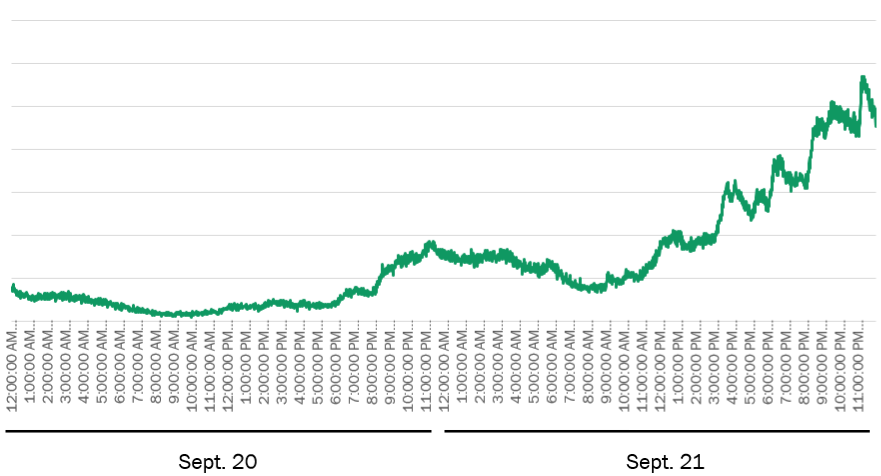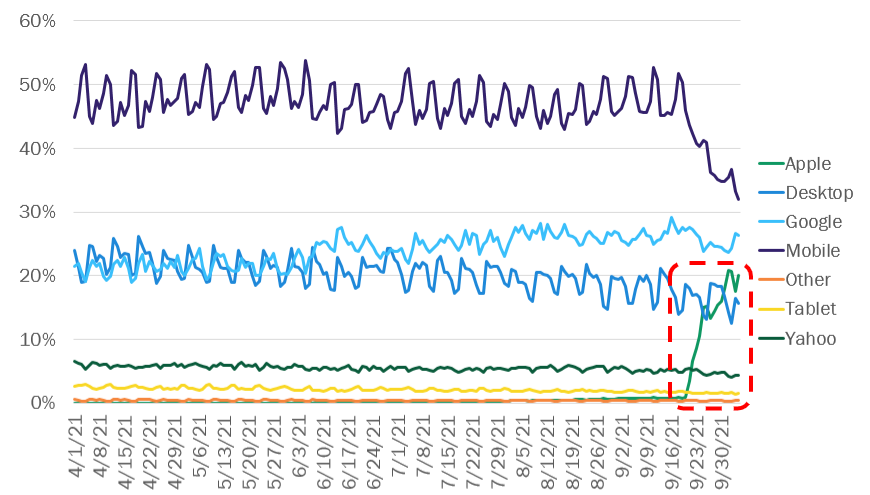
After two weeks of Apple’s Mail Privacy Protection (MPP), we are seeing early indicators of the impact it is having. In case you’ve been living in a parallel digital universe, this means email images are now being automatically pre-fetched for Apple Mail users who have upgraded to the new iOS15 operating system, meaning that tracking pixels will fire regardless of whether recipients have engaged with their emails.
For the October edition of our State of Email Live webinar series, we analyzed Validity’s global email intelligence to find out how MPP is changing email reporting—and the initial observations are fascinating.
What happened on launch day?
Within hours of iOS15 (and MPP) being released, we were already getting some insights into how the new solution was operating:
Starting at midday on September 20th, there was a slow, steady climb. Then, users went home, plugged to power and Wi-Fi, and a sudden surge took place as the auto-updates began. There was a lull during normal sleeping hours, followed by more steady climbing the next day as adoption and acceptance of MPP continued. By the end of day two, pixel fires from Apple Mail users were already in the tens of millions!
How has adoption been trending since then?
This graph shows the device profile of email recipients (e.g., mobile/tablet/desktop). Where this information is not identifiable because of technology like MPP, we report the proxy instead (e.g., Apple/Google/Yahoo).
The emergence of Apple Privacy Proxy usage can be seen rising in the bottom right corner, and initial adoption has been strong:
- Initial take-up wasn’t spectacular, and launch week ended with a relatively modest ± 3.5% adoption rate.
- MPP opt-ins then started climbing strongly, hitting ± 10% by the end of the following week. It is now approaching 20% (19.96% to be precise) at the time of writing.
- Most of the impact has been from mobile devices (iOS15). Note the corresponding decline in “Mobile” as MPP has gained traction.
- Also remember MPP impacts Gmail/Microsoft/Yahoo/etc. subscribers who read their emails using the Apple Mail client, distorting the open rate behavior of these recipients.
Weren’t we expecting a “big bang” adoption?
Almost certainly not! While the above numbers are definitely eye-catching, broader adoption will be an incremental process, and there are several reasons for this:
- iOS adoption isn’t instantaneous. Previous releases have typically achieved two thirds adoption after two to three months, and 90% adoption after nine months.
- Phased global release means many Apple users outside of the US were only prompted to opt in to MPP several days after the official launch date.
- It’s also possible the level of consumers opting in to MPP isn’t as high as we expected it to be. At the same time, we obtained our 20% MPP adoption figure—total iOS15 adoption was 22.3%—suggesting a nine in 10 opt-in rate. It’s still big, but does point to a statistically meaningful opt-out cohort that continues to generate Apple-specific behavioral insights.
What’s happening to open rates?
Global email open rates haven’t gone through the roof (yet!), but they are absolutely trending upwards.
Validity’s data shows the year-to-date trend of around 25% has suddenly risen to 27% over the past two weeks. Remember these numbers represent all subscribers, so the MPP effect for Apple Mail users only (who represent 35% to 40% of the total) will already be ± 2.5x greater.
Are email senders leaning into other metrics yet?
We analyzed Everest usage data for the 10-day period pre-MPP with the corresponding period-MPP, and there are definite signs of our users evaluating substitute data points that will replace increasingly distorted open rates. While Everest user time is still primarily focused on inbox placement and sender reputation, use of the engagement module (device usage, dwell time, etc.) has increased sharply. Of particular interest is the number of inbox tests being carried out—we’ve seen a 17% increase, and senders are clearly leaning into inbox placement as a compensatory metric for lost/degraded open rates.
We also expect to see upward trending for negative metrics like bounces, trap hits, complaints and opt-outs as the ability to gauge subscriber engagement using open rates—and respond to it—diminishes. This will create new deliverability challenges for senders as these metrics feed into worsening sender reputation scores. These trends aren’t yet visible, but we are expecting some of these metrics to be influenced by MPP and will be scrutinizing them for any early clues.
Want to learn more? We’ve created a fantastic MPP resource center where you can find out how Everest can help your email program turn Apple’s challenge into an opportunity to build stronger customer relationships. You can also grab a copy of our great “What the Heck is MPP?” eBook and complete your research by watching a recording of our recent State of Email Live webinar. You’ll find everything you need to change MPP’s meaning into Most Productive Program!


